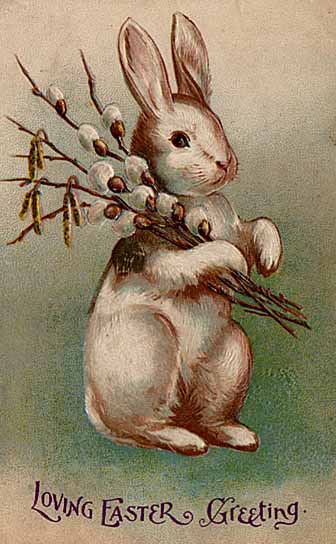Apparently there are pagan links with Easter from the ancient Near East and other places over time, but I just wanted to put out a few from European traditions from Wikipedia.
Etymology
The modern English term Easter, cognate with modern German Ostern, developed from the Old English word Ēastre or Ēostre, which itself developed prior to 899. This is generally held to have originally referred to the name of an Anglo-Saxon goddess, Ēostre, a form of the widely attested Indo-European dawn goddess. The evidence for the Anglo-Saxon goddess, however, has not been universally accepted, and some have proposed that Eostre may have meant "the month of opening" or that the name Easter may have arisen from the designation of Easter Week in Latin as in albis.
Computations
In 725, Bede succinctly wrote, "The Sunday following the full Moon which falls on or after the equinox will give the lawful Easter." However, this does not reflect the actual ecclesiastical rules precisely. One reason for this is that the full moon involved (called the Paschal full moon) is not an astronomical full moon, but the 14th day of a calendar lunar month. Another difference is that the astronomical equinox is a natural astronomical phenomenon, which can fall on 19, 20 March, or 21, while the ecclesiastical date is fixed by convention on 21 March.
Ēostre
Ēostre or Ostara (Northumbrian Old English: Ēostre; West Saxon Old English: Ēastre; Old High German: *Ôstara) is a goddess in Germanic paganism who, by way of the Germanic month bearing her name (Northumbrian: Ēosturmōnaþ; West Saxon: Ēastermōnaþ; Old High German: Ôstarmânoth), is the namesake of the festival of Easter.
Jacob Grimm, *Ostara, and Easter customs
In his 1835 Deutsche Mythologie, Jacob Grimm cites comparative evidence to reconstruct a potential continental Germanic goddess whose name would have been preserved in the Old High German name of Easter, *Ostara. Addressing skepticism towards goddesses mentioned by Bede, Grimm comments that "there is nothing improbable in them, nay the first of them is justified by clear traces in the vocabularies of Germanic tribes." Specifically regarding Ēostre, Grimm continues that:
We Germans to this day call April ostermonat, and ôstarmânoth is found as early as Eginhart. The great christian festival, which usually falls in April or the end of March, bears in the oldest of OHG remains the name ôstarâ ... it is mostly found in the plural, because two days ... were kept at Easter. This Ostarâ, like the [Anglo-Saxon] Eástre, must in heathen religion have denoted a higher being, whose worship was so firmly rooted, that the christian teachers tolerated the name, and applied it to one of their own grandest anniversaries.
Hares and Freyja
In Northern Europe, Easter imagery often involves hares and rabbits. Citing folk Easter customs in Leicestershire, England where "the profits of the land called Harecrop Leys were applied to providing a meal which was thrown on the ground at the 'Hare-pie Bank'", late 19th-century scholar Charles Isaac Elton theorizes a connection between these customs and the worship of Ēostre. In his late 19th-century study of the hare in folk custom and mythology, Charles J. Billson cites numerous incidents of folk custom involving the hare around the period of Easter in Northern Europe. Billson says that "whether there was a goddess named Eostre, or not, and whatever connection the hare may have had with the ritual of Saxon or British worship, there are good grounds for believing that the sacredness of this animal reaches back into an age still more remote, where it is probably a very important part of the great Spring Festival of the prehistoric inhabitants of this island."
Some scholars have linked customs and imagery involving hares to Ēostre and the Norse goddess Freyja. Writing in 1972, John Andrew Boyle cites commentary contained within an etymology dictionary by A. Ernout and A. Meillet, where the authors write that "Little else [...] is known about [Ēostre], but it has been suggested that her lights, as goddess of the dawn, were carried by hares. And she certainly represented spring fecundity, and love and carnal pleasure that leads to fecundity." Boyle responds that nothing is known about Ēostre outside of Bede's single passage, that the authors had seemingly accepted the identification of Ēostre with the Norse goddess Freyja, yet that the hare is not associated with Freyja either. Boyle writes that "her carriage, we are told by Snorri, was drawn by a pair of cats — animals, it is true, which like hares were the familiars of witches, with whom Freyja seems to have much in common." However, Boyle adds that "on the other hand, when the authors speak of the hare as the 'companion of Aphrodite and of satyrs and cupids' and point out that 'in the Middle Ages it appears beside the figure of Luxuria', they are on much surer ground and can adduce the evidence of their illustrations."
Modern popular culture and modern veneration
Jacob Grimm's reconstructed *Ostara has had some influence in popular culture since. The name has been adapted as an asteroid (343 Ostara, 1892 by Max Wolf), a Mödling, Austria-based German nationalist book series and publishing house (1905, Ostara), and a date on the Wiccan Wheel of the Year (Ostara, 21 March). In music, the name Ostara has been adopted as a name by the musical group Ostara, and as the names of albums by :zoviet*france: (Eostre, 1984) and The Wishing Tree (Ostara, 2009). Eostre appears in Neil Gaiman's novel, American Gods.
In some forms of Germanic Neopaganism, Eostre (or Ostara) is venerated. Regarding this veneration, Carole M. Cusack comments that, among adherents, Eostre is "associated with the coming of spring and the dawn, and her festival is celebrated at the spring equinox. Because she brings renewal, rebirth from the death of winter, some Heathens associate Eostre with Idunn, keeper of the apples of youth in Scandinavian mythology."
.



No comments:
Post a Comment